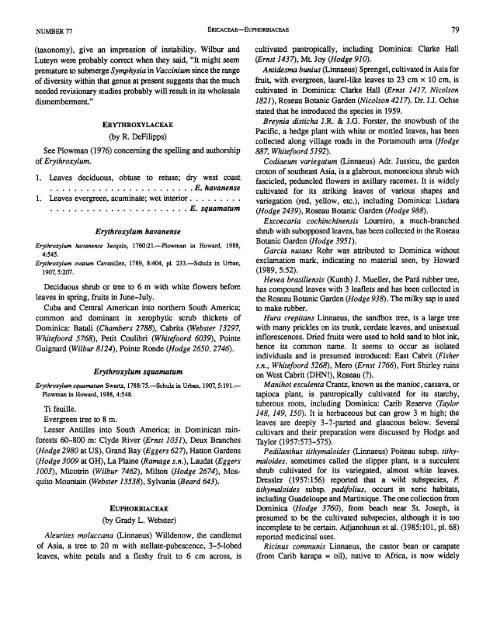Flora of Dominica, Part 2 - Smithsonian Institution Libraries
Flora of Dominica, Part 2 - Smithsonian Institution Libraries
Flora of Dominica, Part 2 - Smithsonian Institution Libraries
You also want an ePaper? Increase the reach of your titles
YUMPU automatically turns print PDFs into web optimized ePapers that Google loves.
NUMBER 77 ERICACEAE-EUPHORBIACEAE 79<br />
(taxonomy), give an impression <strong>of</strong> instability. Wilbur and<br />
Luteyn were probably correct when they said, “It might seem<br />
premature to submerge Symphysia in Vaccinium since the range<br />
<strong>of</strong> diversity within that genus at present suggests that the much<br />
needed revisionary studies probably will result in its wholesale<br />
dismemberment.”<br />
ERYTHROXY LACEAE<br />
(by R. DeFilipps)<br />
See Plowman (1976) concerning the spelling and authorship<br />
<strong>of</strong> Erythroxylum.<br />
1. Leaves deciduous, obtuse to retuse; dry west coast<br />
....................... .E.havanense<br />
1. Leaves evergreen, acuminate; wet interior. ........<br />
....................... E. squamatum<br />
Erythroxylum havanense<br />
Erythroxylum hvanense kcquin, 1760:21.-F’lowman in Howard, 1988,<br />
4545.<br />
Evthroxylwn ovatum Cavanilles, 1789, 8:404, pl. 233.Schulz in Urban,<br />
1907,5:207.<br />
Deciduous shrub or tree to 6 m with white flowers before<br />
leaves in spring, fruits in June-July.<br />
Cuba and Central American into northern South America;<br />
common and dominant in xerophytic scrub thickets <strong>of</strong><br />
<strong>Dominica</strong>: Batali (Chambers 2788), Cabrits (Webster 13297,<br />
Whitefoord 5768), Petit Coulibri (Whitefoord 6039), Pointe<br />
Guignard (Wilbur 8124), Pointe Ronde (Hodge 2650,2746).<br />
Erythroxylum squamatum<br />
Evthroxylwn squamalum Swam, 1788:75.--Schulz in Urban, 1907,5:191.-<br />
Plowman in Howard, 1988,4548.<br />
Ti feuille.<br />
Evergreen tree to 8 m.<br />
Lesser Antilles into South America; in <strong>Dominica</strong>n rainforests<br />
60-800 m: Clyde River (Erst 1031), Deux Branches<br />
(Hodge 2980 at US), Grand Bay (Eggers 623, Hatton Gardens<br />
(Hodge 3009 at GH), La Plaine (Ramage s.n.), Laudat (Eggers<br />
1003), Micotrin (Wilbur 7462), Milton (Hodge 2674), Mosquito<br />
Mountain (Webster 13538), Sylvania (Beard 643).<br />
EUPHORBIACEAE<br />
(by Grady L. Webster)<br />
Aleurites moluccana (Linnaeus) Willdenow, the candlenut<br />
<strong>of</strong> Asia, a tree to 20 m with stellate-pubescence, 3-5-lobed<br />
leaves, white petals and a fleshy fruit to 6 cm across, is<br />
cultivated pantropically, including <strong>Dominica</strong>: Clarke Hall<br />
(Ernst 1433, Mt. Joy (Hodge 910).<br />
Antidesma bunius (Linnaeus) Sprengel, cultivated in Asia for<br />
bit, with evergreen, laurel-like leaves to 23 cm x 10 cm, is<br />
cultivated in <strong>Dominica</strong>: Clarke Hall (Ernst 1417, Nicolson<br />
1821), Roseau Botanic Garden (Nicolson 4217). Dr. J.J. Ochse<br />
stated that he introduced the species in 1959.<br />
Breynia disticha J.R. & J.G. Forster, the snowbush <strong>of</strong> the<br />
Pacific, a hedge plant with white or mottled leaves, has been<br />
collected along village roads in the Portsmouth area (Hodge<br />
887, Whitefoord 5192).<br />
Codiaeum variegatum (Linnaeus) Adr. Jussieu, the garden<br />
croton <strong>of</strong> southeast Asia, is a glabrous, monoecious shrub with<br />
fascicled, peduncled flowers in axillary racemes. It is widely<br />
cultivated for its striking leaves <strong>of</strong> various shapes and<br />
variegation (red, yellow, etc.), including <strong>Dominica</strong>: Lisdara<br />
(Hodge 2439), Roseau Botanic Garden (Hodge 988).<br />
Excoecaria cochinchinensis Loureiro, a much-branched<br />
shrub with subopposed leaves, has been collected in the Roseau<br />
Botanic Garden (Hodge 3951).<br />
Garcia nutans Rohr was attributed to <strong>Dominica</strong> without<br />
exclamation mark, indicating no material seen, by Howard<br />
(1989,5:52).<br />
Hevea brasiliesis (Kunth) J. Mueller, the ParA rubber tree,<br />
has compound leaves with 3 leaflets and has been collected in<br />
the Roseau Botanic Garden (Hodge 938). The milky sap is used<br />
to make rubber.<br />
Hura crepitans Linnaeus, the sandbox tree, is a large tree<br />
with many prickles on its trunk, cordate leaves, and unisexual<br />
inflorescences. Dried fruits were used to hold sand to blot ink,<br />
hence its common name. It seems to occur as isolated<br />
individuals and is presumed introduced: East Cabrit (Fisher<br />
s.n., Whitefoord 5268), Mero (Ernst 1766), Fort Shirley ruins<br />
on West Cabrit (DHN!), Roseau (?).<br />
Manihot esculenta Crantz, known as the manioc, cassava, or<br />
tapioca plant, is pantropically cultivated for its starchy,<br />
tuberous roots, including <strong>Dominica</strong>: Carib Reserve (Tilor<br />
148, 149, 150). It is herbaceous but can grow 3 m high; the<br />
leaves are deeply 3-7-parted and glaucous below. Several<br />
cultivars and their preparation were discussed by Hodge and<br />
Taylor (1957:573-575).<br />
Pedilanthus tithymaloides (Linnaeus) Poiteau subsp. tithymaloides,<br />
sometimes called the slipper plant, is a succulent<br />
shrub cultivated for its variegated, almost white leaves.<br />
Dressler (1957:156) reported that a wild subspecies, P.<br />
tithymuloides subsp. padifolius, occurs in xeric habitats,<br />
including Guadeloupe and Martinique. The one collection from<br />
<strong>Dominica</strong> (Hodge 3760), from beach near St. Joseph, is<br />
presumed to be the cultivated subspecies, although it is too<br />
incomplete to be certain. Adjanohoun et al. (1985:101, pl. 68)<br />
reported medicinal uses.<br />
Ricinus communis Linnaeus, the castor bean or carapate<br />
(from Carib karapa = oil), native to Africa, is now widely
















